Urgent message: The incidence of community-acquired pneumonia (CAP) is seasonal in nature, with a peak during the winter months and a trough in the summer months. In the urgent care setting, primary concerns are risk factors for CAP, as well as current treatment and testing guidelines.
Overview
Pneumonia is an acute alveolar lung infection that presents with infiltrates upon chest imaging and is often accompanied by fever, cough, sputum production, shortness of breath, and physical findings of consolidation and elevated white blood counts. CAP is defined as pneumonia not acquired in a hospital, hospital environment, or a long-term care facility and includes pneumonia caused by bacterial, viral, fungal, and zoonotic organisms. The term community-acquired bacterial pneumonia (CABP) refers to all cases of CAP that are specifically caused by bacteria.
The most common CAP bacterial pathogens include Streptococcus pneumonia (60% of total U.S. incidence), Haemophilus influenza and Moraxella catarrhalis, which account for approximately 85% of the total U.S. incidence of CAP.1 Atypical bacterial pathogens, which do not have a cell wall and cannot be gram stained or cultivated, such as Mycoplasma pneumonia, Legionella, and Chlamydia pneumonia, account for the majority of the remaining cases of CAP. Ambulatory CAP (also known as walking pneumonia) is most common among young adults and is usually due to atypical CAP pathogens.
It is estimated that the U.S. population will increase 38% by 2040; pneumococcal pneumonia hospitalization rates are expected to double in that same time period. Population growth is fastest in older age groups who also experience the highest rates of CAP despite the increase in pneumococcal vaccination rates and improved vaccines.2
Viral causes of pneumonia include rhinovirus, adenovirus, influenza A and B, parainfluenza, and respiratory syncytial virus. A 2015 study published in The New England Journal of Medicine, The Centers for Disease Control and Prevention (CDC) Etiology of Pneumonia in the Community (EPIC) Study, found a higher incidence of viral pneumonia than in previous studies conducted in the 1990s. This may be due to the more sensitive molecular and antigen-based laboratory diagnostic tests currently available.3 Common fungal causes of pneumonia include blastomycosis, coccidioidomycosis, and histoplasmosis.
In addition, it is important that urgent care physicians are aware of the correlation between pneumonia and influenza, as the two diseases have overlapping symptom profiles. Influenza incidence has a seasonality comparable to CAP and can be a predisposing factor for acquiring pneumonia, especially in older adults and those with comorbid conditions. Urgent care physicians should note the potentially deadly correlation between pneumonia and influenza. Pneumonia is the most common complication of influenza, and leads to significant morbidity and mortality.4
Risk factors need to be addressed in a thorough history of any patient with respiratory or other complaints consistent with pneumonia. Doing so can help drive appropriate testing, disposition, and treatment decisions. Take special care to be cognizant of social history, as social risk factors can play a large role in the appropriate care of patients with CAP. Smokers, alcoholics, drug users, the homeless, and those exposed to occupational hazards, as well as patients with other social issues that inhibit their ability to care for themselves, all need to be identified in order to make appropriate clinical decisions, especially regarding patient disposition.
Epidemiology and Incidence
Annual incidence of CAP in the United States is approximately 5 million people, with almost 75% of these cases being treated on an outpatient basis. Pneumonia is the second-leading cause of hospitalization and the eighth-leading cause of death, claiming more lives than breast or prostate cancer.5,6 The associated costs of pneumonia exceed $17 billion each year. Pneumonia is responsible for approximately 3.2 million emergency department visits, 2.6 million hospitalizations, and 4.5 million ambulatory care visits. The Centers for Disease Control (CDC) has stated that drug-resistant S pneumonia (DRSP) is responsible for 1.2 million CAP cases per year and 19,000 excess hospitalizations in the U.S.7
Clinical Presentation
The incubation period for CAP is usually 1-3 days. Symptoms may include abrupt onset of fever and chills or rigors, a productive cough, dyspnea, tachypnea, hypoxia, tachycardia, malaise, and weakness. A sputum-producing cough is the most common presenting symptom, and the color/character of the sputum can assist the clinician in determining the offending pathogen (Table 2). The diagnosis of CAP in elderly patients can be more difficult, as they often do not report classic symptoms but rather present with weakness, mental status changes, or functional decline. Be sure that elderly and other high-risk patients are routinely questioned regarding pneumococcal and influenza vaccination status, because failure to vaccinate increases the risk of CAP.

Pneumonia Risk Factors
The two most important risk factors for patients developing CAP are extremes of age—children who are ≤2 years old and adults who are ≥65 years old. Other risk factors are listed in Table 1.
Risk factors need to be addressed in a thorough history of any patient with respiratory or other complaints consistent with pneumonia. Doing so can help drive appropriate testing, disposition, and treatment decisions. Take special care to be cognizant of social history, as social risk factors can play a large role in the appropriate care of patients with CAP. Smokers, alcoholics, drug users, the homeless, and those exposed to occupational hazards, as well as patients with other social issues that inhibit their ability to care for themselves, all need to be identified in order to make appropriate clinical decisions, especially regarding patient disposition.
Epidemiology and Incidence
Annual incidence of CAP in the United States is approximately 5 million people, with almost 75% of these cases being treated on an outpatient basis. Pneumonia is the second-leading cause of hospitalization and the eighth-leading cause of death, claiming more lives than breast or prostate cancer.5,6 The associated costs of pneumonia exceed $17 billion each year. Pneumonia is responsible for approximately 3.2 million emergency department visits, 2.6 million hospitalizations, and 4.5 million ambulatory care visits. The Centers for Disease Control (CDC) has stated that drug-resistant S pneumonia (DRSP) is responsible for 1.2 million CAP cases per year and 19,000 excess hospitalizations in the U.S.7
Clinical Presentation
The incubation period for CAP is usually 1-3 days. Symptoms may include abrupt onset of fever and chills or rigors, a productive cough, dyspnea, tachypnea, hypoxia, tachycardia, malaise, and weakness. A sputum-producing cough is the most common presenting symptom, and the color/character of the sputum can assist the clinician in determining the offending pathogen (Table 2). The diagnosis of CAP in elderly patients can be more difficult, as they often do not report classic symptoms but rather present with weakness, mental status changes, or functional decline. Be sure that elderly and other high-risk patients are routinely questioned regarding pneumococcal and influenza vaccination status, because failure to vaccinate increases the risk of CAP.
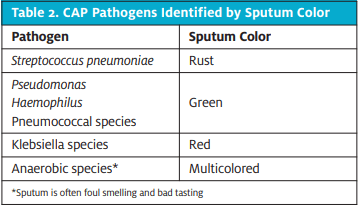
History and Physical Exam
There are many clues to be gleaned from the history of present illness, as well as the social and past medical histories and physical exam (Table 3 and Table 4). For example, patients with concurrent chest pain or shortness of breath (SOB) should have other potential life-threatening cardiologic and pulmonary causes considered as well.
The history may help identify likely pathogens and patients most at risk for CAP. In addition to asking about the classic findings of cough, shortness of breath, fever/chills, and exposure to ill persons, inquire about patients at risk for pneumonia. Knowledge of comorbid conditions such as HIV/AIDS, cancer/chemotherapy, immunosuppressive conditions, COPD, and chronic lung disease may help to localize patients at risk and tailor therapy to organisms specific to patients with these conditions. The social history may reveal recent travel, potential occupational exposures, smoking, alcoholism, and behavior such as IV drug use. Chronic alcoholics and patients with swallowing difficulties are more likely to have aspiration pneumonia associated with gram-negative (Klebsiella pneumoniae, acinetobacter), and anaerobic pathogens. Immunocompromised patients, such as those with HIV, may present with less common pathogens. PCP pneumonia is still the most common opportunistic infection in people with HIV/AIDS. Those with a CD4 cell count <200 are at highest risk.
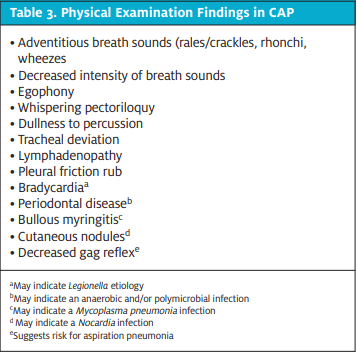
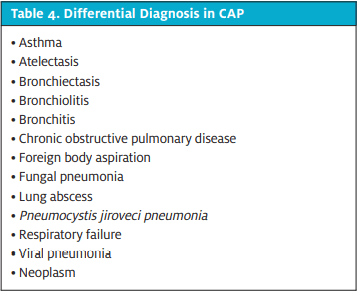
The physical exam should focus first on abnormal vital signs such as tachypnea, tachycardia, or low pulse oximetry. The general appearance of the patient may reveal clues such as confusion, use of accessory muscles/nasal flaring in an infant, or intermittent coughing or a whoop (pertussis). Lung findings may include adventitious breath sounds such as crackles, rhonchi, or wheezing. Examine the skin for track marks (possibly indicating IV drug use), the mouth for oral hairy leucoplakias (pearly, vertically oriented lines on the tongue which is associated with AIDS), and clubbing or cyanosis suggestive of COPD.
Vaccination
Most pneumococci are encapsulated with complex capsular polysaccharides. These polysaccharides are antigenic and form the basis for classifying pneumococci by serotypes. There were 92 serotypes documented as of 2011. In recent years, these polysaccharides have been used to develop effective pneumococcal vaccines. Pneumococci are common asymptomatic inhabitants of the nasopharynx.
Persons who are at increased risk for CAP, as described previously, should receive pneumococcal vaccines as recommended by the CDC.
Pneumococcal conjugate vaccine PCV13 (PREVNAR 13) is recommended for all children <5 years old, all adults ≥65 years, and people ≥6 years with certain risk factors. Pneumococcal polysaccharide vaccine PPSV23 (Pneumovax) is recommended for all adults ≥65 years or older. People age 2–64 years old who are at high risk of pneumococcal disease should also receive PPSV23. The timing of vaccination varies by age and the presence of comorbid/high-risk conditions. Currently, only 63% of adults >65 years are properly vaccinated and less than 25% of adults in other high risk groups are vaccinated.7 Urgent care clinicians play an increasingly important role in their communities, and should encourage pneumococcal vaccination when indicated.
Radiography
Though management may be based on a clinical diagnosis, the IDSA guidelines state that chest x-rays are considered the standard method for diagnosing the presence of pneumonia; the presence of an infiltrate confirms the diagnosis.8 Despite that, it must be noted that the accuracy of plain chest radiography for detecting pneumonia is dependent on several variables including the experience of the interpreting clinician, the stage of infection (initial stage more difficult to detect), dehydration, and confounding factors such as concurrent congestive heart failure and chronic lung disease. Recent prospective and retrospective studies have shown that in patients admitted with a clinical diagnosis of CAP, the initial chest radiograph lacks sensitivity and may not demonstrate an infiltrate in 11%-47% of patients.9 Even with the absence of radiologic findings, clinicians should consider empiric antibiotic treatment if there remains a high clinical suspicion for CAP. Clinical variables that should raise suspicion for the diagnosis of pneumonia include: age >65 years, moderate to severe comorbid conditions, and current smokers. Historical and physical exam findings that increase the suspicion of pneumonia include fever, chills, sputum production, orthopnea, altered mental status, cyanosis, dullness on percussion, crackles, abnormal vital signs (ie, HR>100 beats/min, RR>20 breaths/min or T>100.4 degrees F), and room air O2 sat <92%. Another study revealed that patients with and without radiographic confirmation of pneumonia had similar rates of positive sputum cultures and blood cultures during hospitalization. The authors concluded that the absence of radiographic findings should not supersede clinical judgment and empiric treatments in these patients.10
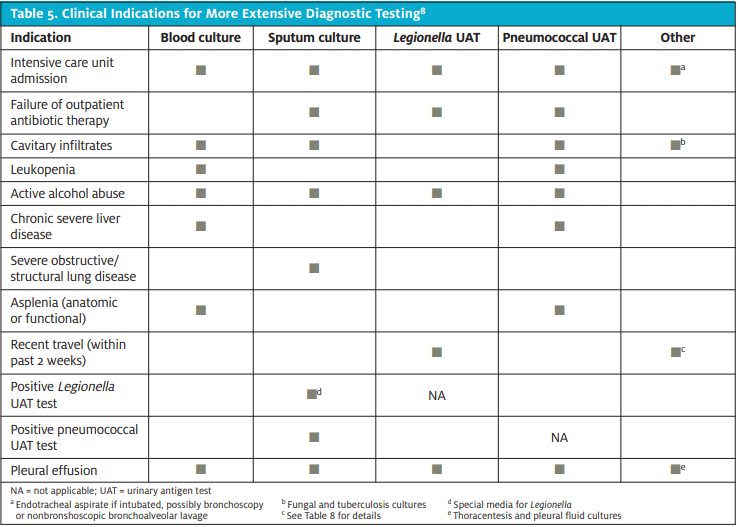
Laboratory
Laboratory tests may include a serum chemistry panel and complete blood count (CBC) with differential. CBC results may reveal leukocytosis with a left shift in a bacterial infection, yet its absence (particularly in elderly patients) should not cause the clinician to discount the possibility of a bacterial infection, as leukopenia may be a clinical sign of impending sepsis.
Other options include pneumococcal and Legionella urine antigen testing. Per the most recent IDSA guidelines: “Patients with CAP should be investigated for specific pathogens that would significantly alter standard (empirical) management decisions, when the presence of such pathogens is suspected on the basis of clinical and epidemiologic clues. (Strong recommendation; level II evidence.)”8 Specifically, IDSA recommends S pneumoniae urine antigen testing for patients with the following clinical indications: outpatient antibiotic therapy failure, leukopenia, active alcohol abuse, severe liver disease, asplenia, pleural effusion, and intensive care unit admission (Table 5). The IDSA guidelines recommend Legionella urine antigen testing only for the following indications: failed outpatient antibiotic therapy for CAP, require intensive care admission, immunocompromised, exposure to an outbreak of Legionnaires’ disease, or travel history within 2 weeks before onset of illness. Further study and clinical experience is still needed to clarify the clinical value of newer advanced molecular testing and biological markers, especially in the urgent care environment.
Serologic assays and sputum cultures can be nonspecific, while blood cultures are insensitive. Neither are practical nor indicated in the urgent care setting.
Risk Stratification
Initial risk stratification in CAP helps guide the clinician in major decisions regarding diagnostic modalities, treatment decisions, and patient disposition (site of care). The site-of-care decision on whether or not a patient needs hospital admission is an important economic consideration in CAP, as the cost of inpatient care for pneumonia is logarithmically higher than outpatient care. Low-risk CAP patients should be treated as outpatients whenever possible to avoid complications of hospital-acquired superinfections and thromboembolic events. Also, CAP patients treated as outpatients are more likely to return to work and other activities faster than those admitted as inpatients. It is important to understand that most people prefer to be treated as outpatients whenever possible. Providers should also consider barriers to outpatient treatment such as frailty, lack of response to previous therapy, severe social or psychiatric problems, substance abuse, homelessness, and unstable living conditions when making site-of-care treatment decisions.
Severity-of-illness scores, such as the CURB-65 criteria, or prognostic models, such as the Pneumonia Severity Index (PSI), can be used to identify patients with CAP who may be candidates for outpatient treatment. The PORT score (based on the PSI scoring system) is a tool used to help guide the decision regarding the site of care (Table 6 and Table 7). The stratified risk classes are based on measured mortality rates within 30 days of diagnosis. All patients ≤50 years of age who have none of the coexisting illnesses or physical examination abnormalities identified in step one of the rule are assigned risk class I and should be candidates for outpatient treatment due to very low mortality rates. Risk class II patient also have low mortality rates; it is recommended that these patients also be treated at home. Patients in class III may benefit from a period of observation in the emergency room before a decision is made regarding the site of care, but patients in risk classes IV and V require hospital admission. Any patient >50 years of age is automatically classified as at least risk class II, even if they have no7 other risk criteria. PSI scores may underestimate the patient’s need for admission due to barriers to outpatient admission mentioned above.
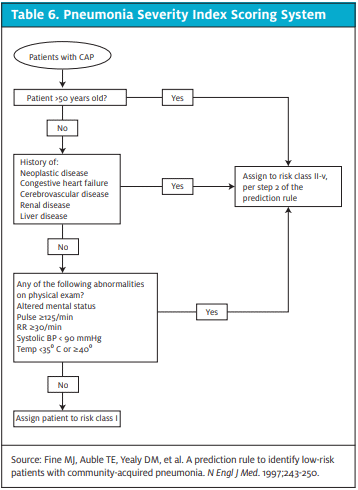
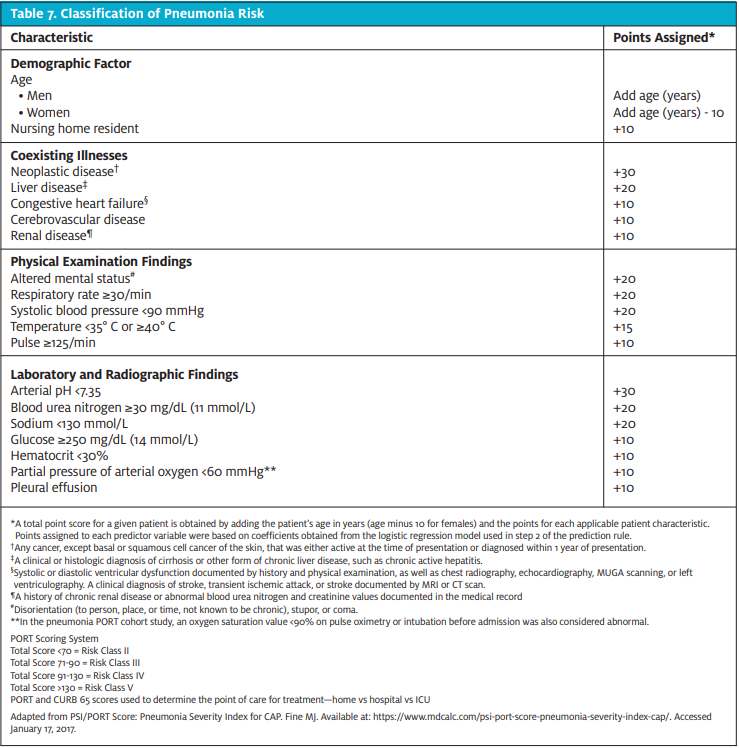
Conversely, the PSI may overestimate the mortality in higher-risk patients. The IDSA guidelines also recommend that physicians consider home therapy for patients in PSI risk classes I, II, and III.
The CURB-65 scale is simpler to use in determining pneumonia severity, yet it is less sensitive than the PSI (Table 8). Clinicians assign one point for each criterion (eg, confusion, blood urea nitrogen, respiratory rate, blood pressure, age) met by the patient. If the individual scores 0-1 points, then outpatient treatment is appropriate. Two points indicates hospitalization and inpatient treatment. A score of 3 or more points warrants inpatient treatment in the intensive care unit. The use of the CURB-65 and PORT scores may be problematic in the urgent care setting, as many centers do not have point-of-care diagnostic testing or access to arterial blood gas testing. If a center does not have the ability for point-of-care blood urea nitrogen testing and the patient still has a CURB-65 score of 2 or higher, then they clearly meet hospital admission criteria.
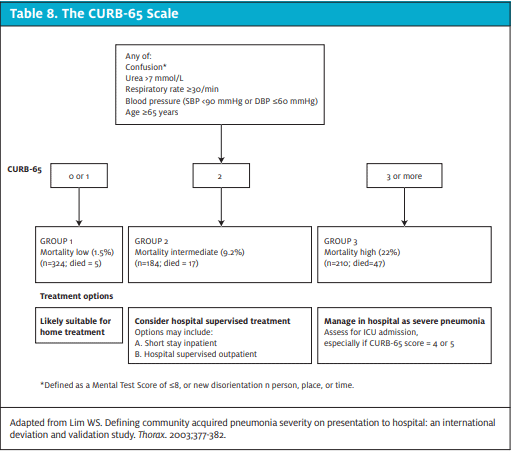
Treatment
The IDSA and the Thoracic Society of America (TSA) provide excellent evidence-based guidelines for the treatment of outpatients, inpatients, and ICU patients with CAP. The IDSA/TSA Consensus Guidelines on the Management of Community Acquired Pneumonia in Adults8 for outpatient CAP recommend the following:
- Outpatient Treatment
- Previously healthy and no risk factors for DRSP infection:
- A macrolide (azithromycin, clarithromycin, or erythromycin) (strong recommendation; level I evidence) OR
- Doxycycline (weak recommendation; level III evidence)
- Presence of comorbidities, such as:
- Chronic heart, lung, liver, or renal disease; diabetes mellitus; alcoholism; malignancies; asplenia; immunosuppressing conditions; or use of immunosuppressing drugs
- Use of antimicrobials within the previous 3 months (in which case an alternative from a different class should be selected)
- Other risks for DRSP infection
- A respiratory fluoroquinolone (moxifloxacin, gemifloxacin, or levofloxacin (750 mg daily) (strong recommendation; level I evidence) OR
- A beta lactam PLUS a macrolide (strong recommendation; level I evidence)
- High-dose amoxicillin (eg, 1 g 3 times daily) or amoxicillin-clavulanate (2 g 2 times daily) are preferred beta lactams
- Alternative beta lactams include ceftriaxone, cefpodoxime, and cefuroxime
- Doxycycline [level II evidence] is an alternative to the macrolide
As bacterial resistance rates have increased, new pneumococcal serotypes have been identified, and referred to as drug-resistant Streptococcus pneumoniae (DRSP). These DRSP serotypes are particularly resistant to currently available macrolides, such as azithromycin. The current IDSA guidelines on the management of CAP recommend the use of an alternative to macrolides in areas where DRSP rates are >25%.8 They also recommend clinicians become aware of the prevalence of drug-resistant pneumococci in their treatment area to help aid antibiotic decision making.
Most large hospital systems produce antibiograms which detail local bacterial resistance rates to common CAP pathogens and can aid the urgent care clinician in their treatment decision. Macrolide resistant rates of >25% in the U.S. leave clinicians with little choice in the outpatient treatment of CAP other than doxycycline or the fluoroquinolones. In July 2016, the FDA issued new warnings on the fluoroquinolone class in regard to side effects involving tendons, muscles, joints, nerves, and the central nervous system and stated that the risk of these side effects outweigh the benefits for patients with acute bacterial sinusitis, acute exacerbation of chronic bronchitis, and uncomplicated urinary tract infections. Routine use of fluoroquinolones for the above diagnoses in the urgent care setting should be avoided whenever possible. However, the FDA did determine that the benefits of fluoroquinolone use outweigh the risks of side effects for serious bacterial infections such as pneumonia.11 Fluoroquinolones are also more likely to cause Clostridium difficile infection than either doxycycline or the macrolides.9. Along with local resistance rates, it is important that antibiotic selection decision making take into account the patient’s risk factors for possible infection with DRSP (Table 9). DRSP risk factors were present in approximately half of outpatient CAP cases treated in the acute care setting; however, guideline-concordant antibiotic therapy was infrequent.12
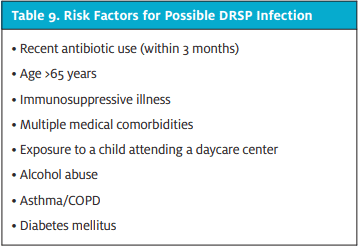
The most prevalent causative organism in CAP is S pneumoniae, regardless of the host or the setting. Empiric antibiotic therapy should always be selected with this microorganism and its drug-resistant serotypes in mind.
The IDSA guidelines recommend that patients with CAP should be treated for a minimum of 5 days (Level I evidence), should be afebrile for 48-72 hours, and should have no CAP-associated sign of clinical instability (ie, T>37.8 C, HR>100, RR>24, SBP<100, room air O2 sat<90, inability to maintain oral intake, or altered mental status) before therapy is completed.8 Longer therapy is usually reserved for patients with prolonged clinical instability and for nonresponders if the initial therapy was not active against an identified pathogen. Response to antibiotic therapy should be evaluated within 48-72 hours of treatment initiation, as the vast majority of outpatients with CAP become clinically stable in that timeframe. Urgent care clinicians should ensure that patients are closely followed up, whether via a confirmed referral or repeat urgent care visit. Antibiotics should not be changed within the first 72 hours unless marked clinical deterioration occurs or the causative pathogen is identified. Chest x-rays usually clear within 4 weeks in patients <50 years old, yet resolution can be delayed for ≥12 weeks in older individuals. Patients of any age who remain symptomatic should undergo follow-up imaging.13
Conclusion
Community-acquired pneumonia remains a deadly disease and is commonly encountered in the urgent care setting, especially in the winter months and during “flu season.” Urgent care clinicians should take care to choose the proper disposition for patients with CAP and make sure patients receive adequate follow-up referrals and instructions. Awareness of current treatment options, local antibiotic resistance rates, and length-of-treatment guidelines will help the clinician in providing the current standard of care in CAP. The diagnosis of CAP by clinical presentation along with the presence of diagnostic chest x-ray findings should be followed by empiric treatment with the most narrow-spectrum and safest drug possible. Assessment of local resistance patterns is important for appropriate treatment considerations, along with risk stratification. Additional diagnostic testing and pathogen identification is a consideration when appropriate pretest indications are present, though their utility in urgent care has not yet been established.
Citation: Harnett G, Sellers J. Urgent care evaluation of pneumonia. J Urgent Care Med. February 2017. Available at: https://www.jucm.com/urgent-care-evaluation-pneumonia/.
References
- Woolfrey KG. Pneumonia in adults: the practical emergency department perspective. Emerg Med Clin North Am. 2012;30(2):249-270.
- Wroe PC, Finkelstein JA, Ray GT, et al. Aging population and future burden of pneumococcal pneumonia in the United States. J Infect Dis. 2012;205(10):1589-1592.
- Jain S, Self WH, Wunderink RG, et al. Community-acquired pneumonia requiring hospitalization. N Engl J Med. 2015;373(24):2380-2382.
- Klein EY, Monteforte B, Gupta A, et al. The frequency of influenza and bacterial coinfection: a systematic review and meta-analysis. Influenza Other Respir Viruses. 2016. [Epub ahead of print.]
- Pfunter A, Wier LM, Stocks C. Most frequent conditions in U.S. hospitals, 2010. HCUP Statistical Brief #148. Rockville, MD: Agency for Healthcare Research and Quality; January 2013. Rockville, MD. Available at: http://www.hcup-us.ahrq.gov/reports/statbriefs/sb148.pdf. Accessed 15 July 2016.
- Xu J, Murphy SL, Kochanek KD, et al. Deaths: final data for 2013. Natl Vital Stat Rep. 2016;64(2):1-119.
- Centers for Disease Control and Prevention. Antibiotic Resistance Threats in the United States, 2013. Atlanta, GA; Centers for Disease Control and Prevention, U.S. Department of Health and Human Services.
- Mandell LA, Wunderink RG, Anzueto JG, et al. Infectious Diseases Society of America/American Thoracic Society consensus guidelines on the management of community-acquired pneumonia in adults. Clin Infect Dis. 2007;44 Suppl 2:S27-72.
- Owens RC Jr, Donskey CJ, Gaynes RP, et al. Antimicrobial‐associated risk factors for Clostridium difficile Infection. Clin Infect Dis. 2008;15;46 Suppl 1:S19-31.
- Basi SK, Marrie TJ, Huang JQ, et al. Patients admitted to hospital with suspected pneumonia and normal chest radiographs: epidemiology, microbiology, and outcomes. Am J Med. 2004;117(5):305-311.
- Food and Drug Administration. FDA Drug Safety Communication: FDA updates warnings for oral and injectable fluoroquinolone antibiotics due to disabling side effects. July 26, 2016. Available at: http://www.fda.gov/downloads/Drugs/DrugSafety/UCM513019.pdf. Accessed January 17, 2017.
- Jenkins TC, Sakai J, Knepper BC, et al. Risk factors for drug-resistant Streptococcus pneumoniae and antibiotic prescribing practices in outpatient community-acquired pneumonia. Acad Emerg Med. 2012;19(6):703-706.
- Tang KL, Eurich DT, Minhas-Sandhu JK, et al. Incidence, correlates, and chest radiographic yield of new lung cancer diagnosis in 3398 patients with pneumonia. Arch Intern Med. 2011; 171(13):1193-1198.
